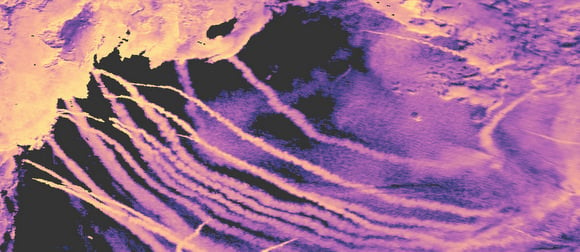Are you ready for another Where In The Universe Challenge? Take a look and see if you can name where in the Universe this image is from. Give yourself extra points if you can name the spacecraft responsible for the image. As usual, we'll provide the image today, but won't reveal the answer until tomorrow. This gives you a chance to mull over the image and provide your answer/guess in the comment section — if you dare! Check back tomorrow on this same post to see how you did. Good luck!
UPDATE: The answer has now been posted below.
This image was taken on On March 4, 2009, by the Moderate Resolution Imaging Spectroradiometer (MODIS) on NASA's Terra satellite. It is not plane contrails as some have suggested, but clouds that formed over the northeast Pacific Ocean that form around the particles in ship exhaust. This image shows how these ship "tracks" are different from the natural marine clouds in the same area. You can see a natural-color view of this image
here,
but from this enhanced image, scientists can determine the size of the cloud droplets.
Cloud droplets form when water vapor condenses onto a small particles, like the ship exhaust. The ship tracks are brighter than the regular clouds because the cloud particles in them are smaller (yellow and peach), but more numerous, than the particles in the natural clouds (lavender to dark purple).
Why are scientists concerned with cloud brightness? A cloud's brightness impacts how much sunlight gets bounced back to space and how much reaches the surface of the Earth, which influences global climate. The size of the droplets also influences the amount of rain the clouds produce; smaller droplets are less likely to collide and form drops that are big enough to fall as rain.
How'd you do? Check back next week for another WITU Challenge!
 Universe Today
Universe Today
